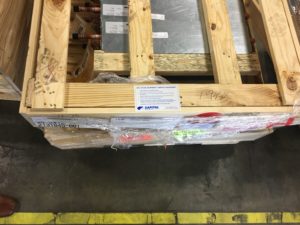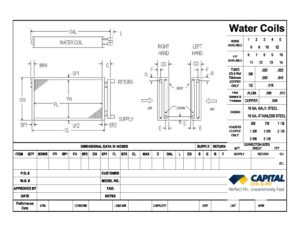1. Are you replacing an existing coil or are you installing a coil for a new application? This is always the first question you will be asked. If you are replacing an existing coil, matching up the dimensions of the coil is your first responsibility and matching up performance is easy. It just happens.
2. The laws of physics apply to coils like everything else. If you match up the physical size of the coil, the rows deep and the fins/inch, you will match or exceed the performance at a minimum.
3. If you don’t know the performance, then based on the physical size of the coil, you can ask somebody to run you a typical performance. There are standard air velocities, standard fluid temperatures and other performance requirements that dictate what a typical performance could be. Of course all of this is based on the idea that you are talking to a supplier that knows what he/she is doing and can walk you through this.
4. Coils fail primarily for four reasons. The first is old age. The second is that the coil failed prematurely and you must discover the reason it failed…or you’ll just duplicate the problem. The third is the coil froze in some manner. The fourth is that the coil never worked properly from the beginning of the installation. Your replacement coil has to fit in one of these four categories.
5. If a coil dies of old age, then consider the application to be a lucky one and duplicate the coil. “Old age” can be defined as roughly 15 years or more. Duplicate the coil as exact as possible, slide the old coil out, and slide the new coil in.
6. Coils can fail prematurely for a variety of reasons. It could be corrosion or erosion. Maybe the system is not set up correctly for the coil. But, if the coil fails in 2 or 3 years, you need to be asking yourself some of these questions about the coil and the system. And something needs to change so you don’t duplicate the problem!
7. Coils freeze and that’s a fact of life. Coils do not freeze mysteriously by themselves. They are not independent of the system. Something in the system needs to be corrected. A good replacement coil supplier will work with you and give you lots of engineering recommendations and suggestions.
8. If the coil never worked correctly from the beginning, then change it. It’s very easy to determine where you are and where you need to be in terms of coil performance. Again, it takes a replacement coil supplier who is willing to work with you instead of berating you for asking questions.
9. You never get something for free when you buy a replacement coil. Coils can become more economical if you increase the fins/inch and decrease the rows. But it’s a trade off because you also increase the air pressure drop and cleaning the coil becomes much more difficult when the increased fins/inch acts like a filter. There are all kinds of shortcuts that you can take to build a coil that will save you money. None of them lead to a good coil selection and low energy costs. The saying “you get what you pay for” is never truer than in buying coils. There is always a “balance”. You need to find it with your replacement coil supplier.
10. There is an urgency to any replacement coil installation. There is an urgency to designing the replacement coil properly. There is an urgency to getting an competitive price. There is an urgency to getting the approval drawings. There is an urgency to shipping the replacement coil out on time. There is an urgency to delivering the coil. You must work with a supplier that can recognize you situation individually and provide you with the service that you require. At Capital Coil & Air, we’re the best in the industry in all of the above. We look forward to working with you on future projects!


